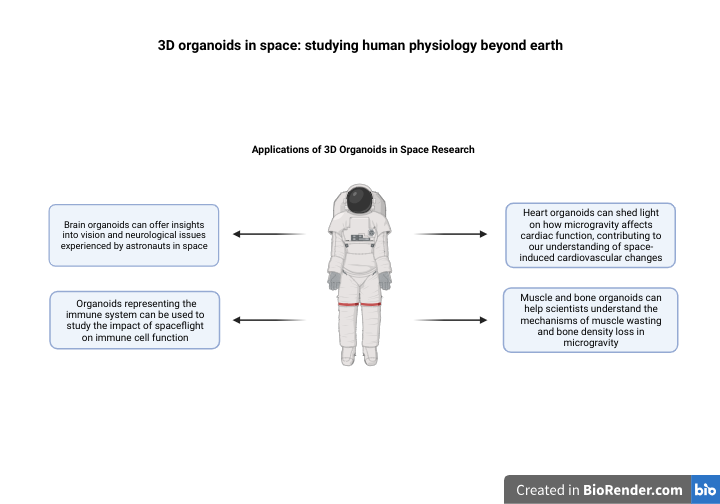
3D organoids in space: studying human physiology beyond earth
Space exploration has always captured the human imagination, and as we venture beyond our planet, the study of human physiology in microgravity environments has become increasingly vital. 3D organoids, miniature organ models grown from human cells, are invaluable tools in understanding how spaceflight affects the human body and may hold the key to mitigating health risks for astronauts on long-duration missions (1).
This article explores the cutting-edge use of 3D organoids in space research, shedding light on the unique challenges and promising discoveries in this emerging field.
The challenges of space travel on human physiology Space travel presents a range of physiological challenges for astronauts. Microgravity, radiation exposure, and isolation can lead to various health issues, including muscle and bone loss, cardiovascular changes, immune system alterations, and vision problems. Studying these effects is crucial for ensuring the well-being of astronauts on missions to the Moon, Mars, and beyond (1,2).
The Promise of 3D Organoids 3D organoids, cultivated from human cells, provide a novel platform for studying the impact of space travel on human physiology. These tiny, self-organizing structures closely mimic the structure and function of specific organs, offering a more accurate representation of human biology than traditional 2D cell cultures. In the context of space research, 3D organoids offer several advantages (2,3):
– Customization: Researchers can generate organoids representing different human organs, enabling the study of diverse physiological systems and their responses to space conditions.
– Long-Term Studies: Organoids can be maintained for extended periods, allowing scientists to investigate the cumulative effects of space travel on human tissues.
– Reduced Ethical Concerns: Using organoids reduces the need for animal testing and raises fewer ethical concerns than experiments involving live subjects.
The Future of Space Medicine As space agencies plan for long-duration missions to distant destinations, studying human physiology in space has never been more critical. 3D organoids are poised to play a pivotal role in this endeavor, offering a dynamic and versatile platform for understanding how space conditions affect the human body and developing strategies to safeguard the health of astronauts on their interstellar journeys. As technology advances and our knowledge grows, 3D organoids in space research promise to unlock new frontiers in space medicine and human space exploration (4).
References
1. Grimm D, Wehland M, Pietsch J, Aleshcheva G, Wise P, van Loon J, Ulbrich C, Magnusson NE, Infanger M, Bauer J. Growing tissues in real and simulated microgravity: new methods for tissue engineering. Tissue Eng Part B Rev. 2014 Dec;20(6):555-66. doi: 10.1089/ten.TEB.2013.0704. Epub 2014 Apr 4. PMID: 24597549; PMCID: PMC4241976.
2. Grimm D. Microgravity and Space Medicine 2.0. Int J Mol Sci. 2022 Apr 18;23(8):4456. doi: 10.3390/ijms23084456. PMID: 35457274; PMCID: PMC9029223.
3. Scott JM, Stoudemire J, Dolan L, Downs M. Leveraging Spaceflight to Advance Cardiovascular Research on Earth. Circ Res. 2022 Mar 18;130(6):942-957. doi: 10.1161/CIRCRESAHA.121.319843. Epub 2022 Mar 17. PMID: 35298305; PMCID: PMC8985452.
4. Pavez Loriè E, Baatout S, Choukér A, Buchheim JI, Baselet B, Dello Russo C, Wotring V, Monici M, Morbidelli L, Gagliardi D, Stingl JC, Surdo L, Yip VLM. The Future of Personalized Medicine in Space: From Observations to Countermeasures. Front Bioeng Biotechnol. 2021 Dec 13;9:739747. doi: 10.3389/fbioe.2021.739747. PMID: 34966726; PMCID: PMC8710508.



